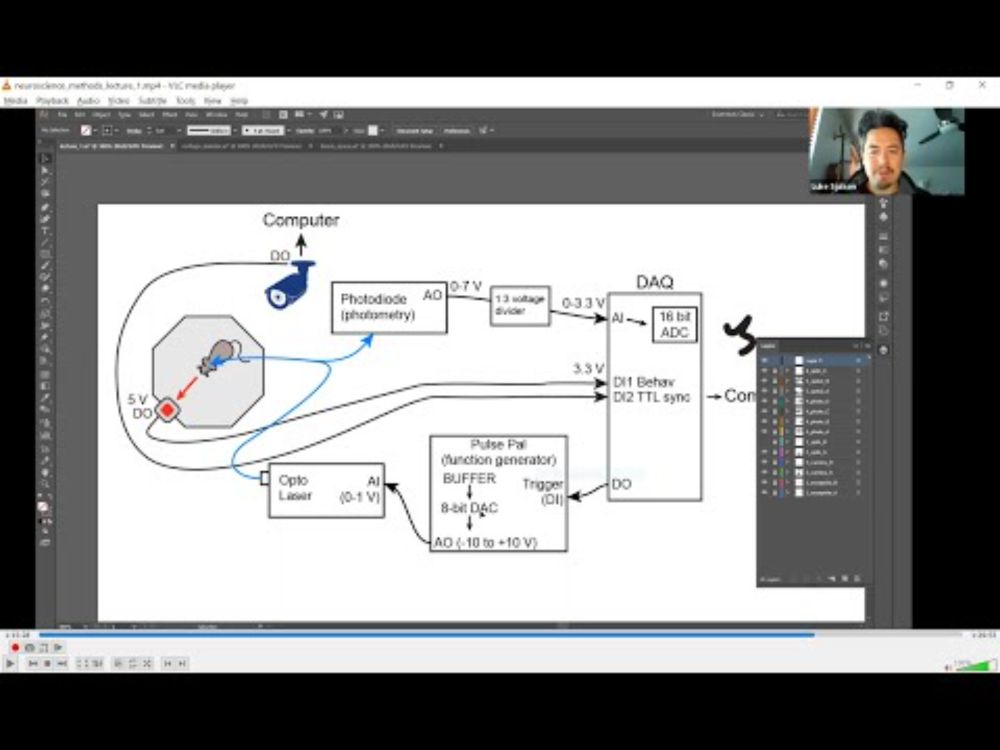

Please like and repost to help us get the word out!
www.youtube.com/playlist?lis...
Lecture 1: Signals and data acquisition
Focusing on hardware, digital/analog I/O, synchronization
🧵

We love to trash dominant hypothesis, but we need to look for evidence against the manifold hypothesis elsewhere:
This elegant work doesn't show neural dynamics are high D, nor that we should stop using PCA
It’s quite the opposite!
(thread)

We love to trash dominant hypothesis, but we need to look for evidence against the manifold hypothesis elsewhere:
This elegant work doesn't show neural dynamics are high D, nor that we should stop using PCA
It’s quite the opposite!
(thread)
@eliezyer.bsky.social and I will do a full thread on this when the paper comes out, but his work shows it's (as usual) a little more complicated 🧵
@eliezyer.bsky.social and I will do a full thread on this when the paper comes out, but his work shows it's (as usual) a little more complicated 🧵
www.ucl.ac.uk/cortexlab/po...

www.ucl.ac.uk/cortexlab/po...

Findlay is reportedly ok.
I made a video explainer about why.
Stay for last post, w link to @science.org story from @jocelynkaiser.bsky.social
1/4
🧪
I made a video explainer about why.
Stay for last post, w link to @science.org story from @jocelynkaiser.bsky.social
1/4
🧪
When the president and Supreme Court are both acting lawlessly, Congress must stand up and stop it.
US science is collapsing and Congress needs to act.
🧪
Full video here: www.instagram.com/reel/DP1tXXE...
When the president and Supreme Court are both acting lawlessly, Congress must stand up and stop it.
US science is collapsing and Congress needs to act.
🧪
Full video here: www.instagram.com/reel/DP1tXXE...

www.nature.com/articles/s41...

www.nature.com/articles/s41...
*assuming you think the brain operates through the parallel activity of many connected input/output units
*assuming you think the brain operates through the parallel activity of many connected input/output units
www.hamamatsu.com/jp/en/why-ha...

www.hamamatsu.com/jp/en/why-ha...

I didn't spend 10 years in mines of academia to be told ignorance is morally equal knowledge.
We know exactly how LLMs work.
With @vitorlds.bsky.social and David Dupret, we show that diversity in ripple current profiles shapes reactivation dynamics

With @vitorlds.bsky.social and David Dupret, we show that diversity in ripple current profiles shapes reactivation dynamics
www.biorxiv.org/content/10.1...
www.biorxiv.org/content/10.1...
Jess Breda and I developed a protocol for training center-port nose fixation 61% faster than a previous curriculum while keeping violation rates low.
Preprint here: www.biorxiv.org/content/10.1...

Jess Breda and I developed a protocol for training center-port nose fixation 61% faster than a previous curriculum while keeping violation rates low.
Preprint here: www.biorxiv.org/content/10.1...
We found a preference for visual objects in the mouse spatial navigation system where they dynamically refine head-direction coding. In short, objects boost our inner compass! 🧭
www.science.org/doi/10.1126/...
🧵1/

We found a preference for visual objects in the mouse spatial navigation system where they dynamically refine head-direction coding. In short, objects boost our inner compass! 🧭
www.science.org/doi/10.1126/...
🧵1/


